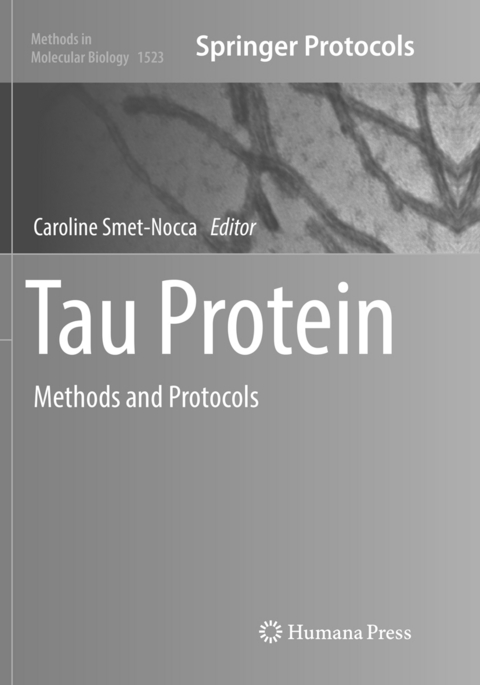
Tau Protein
Humana Press Inc. (Verlag)
978-1-4939-8246-2 (ISBN)
Practical and cutting-edge, Tau Protein: Methods and Protocols is a valuable resource that addresses the most recent aspects of Alzheimer’s disease research related to Tau protein and state-of-the-art experimental techniques. It targets a broad scientific audience including molecular biologists and biochemists, as well as all researchers interested in exploring the functions of tau proteins.
Conformational Dynamics of Intracellular Tau Protein Revealed by CD and SAXS.- Global Conformation of Tau Protein Mapped by Raman Spectroscopy.- Molecular Dynamics Simulation of Tau Peptides for the Investigation of Conformational Changes Induced by Specific Phosphorylation Patterns.- Tau Interaction with Tubulin and Microtubules: From Purified Proteins to Cells.- X-Ray Structural Study of Amyloid-Like Fibrils of Tau Peptides Bound to Small-Molecule Ligands.- Detection and Quantification Methods for Fibrillar Products of In Vitro Tau Aggregation Assays.- Fourier Transform Infrared (FTIR) Spectroscopy, Ultraviolet Resonance Raman (UVRR) Spectroscopy and Atomic Force Microscopy (AFM) for Study of the Kinetics of Formation and Structural Characterization of Tau Fibrils.- Assays for the Screening and Characterization of Tau Aggregation Inhibitors.- Tau Oligomers as Pathogenic Seeds: Preparation and Propagation In Vitro and In Vivo.- Mass Spectrometry Analysis of Lysine Post-Translational Modifications of Tau Protein from Alzheimer’s Disease Brain.- The Study of Posttranslational Modifications of Tau Protein by Nuclear Magnetic Resonance Spectroscopy: Phosphorylation of Tau Protein by ERK2 Recombinant Kinase and Rat Brain Extract, and Acetylation by Recombinant Creb-Binding Protein.- Tag-Free Semi-Synthesis of Tau Protein.- Production of O-GlcNAc Modified Recombinant Tau in E.coli and Detection of Ser400 O-GlcNAc Tau In Vivo.- Two-Dimensional Electrophoresis Protocols to Analyze the Microtubule-Associated Tau Proteins from Several Biological Sources.- A Simple Method to Avoid Non-Specific Signal When Using Monoclonal Anti-Tau Antibodies in Western Blotting of Mouse Brain Proteins.- Flow Cytometry Analysis and Quantitative Characterization of Tau in Synaptosomes from Alzheimer’s Disease Brains.- In Vivo Microdialysis of Brain Interstitial Fluid for the Determination of Extracellular Tau Levels.- Proximity Ligation Assay: A Tool to Study Endogenous Interactions between Tau and its Neuronal Partners.- Finding MAPT Mutations in Frontotemporal Dementia and Other Tauopathies.- Tracking Tau in Neurons: How to Grow, Fix and Stain Primary Neurons for the Investigation of Tau in All Developmental Stages.- Tracking Tau in Neurons: How to Transfect and Track Exogenous Tau into Primary Neurons.- Image-Based Analysis of Intracellular Tau Aggregation by Using Tau-BiFC Cell Model.- FRET and Flow Cytometry Assays to Measure Proteopathic Seeding Activity in Biological Samples.- In Vivo Imaging of Tau Aggregates in the Mouse Retina.- In Vivo Hyperthermic Stress Model: An Easy Tool to Study the Effects of Oxidative Stress on Neuronal Tau Functionality in Mouse Brain.- Identification of Tau Toxicity Modifiers in the Drosophila Eye.- Regulation of Neurotrophic Factors during Pathogenic Tau-Aggregation: A Detailed Protocol for Double-Labeling mRNA by In Situ Hybridization and Protein Epitopes by Immunohistochemistry.- Pin1 Knockout Mice: A Model for the Study of Tau Pathology in Alzheimer's Disease.
| Erscheinungsdatum | 28.08.2018 |
|---|---|
| Reihe/Serie | Methods in Molecular Biology ; 1523 |
| Zusatzinfo | 64 Illustrations, color; 19 Illustrations, black and white; XVIII, 432 p. 83 illus., 64 illus. in color. |
| Verlagsort | Totowa, NJ |
| Sprache | englisch |
| Maße | 178 x 254 mm |
| Themenwelt | Naturwissenschaften ► Biologie ► Biochemie |
| Naturwissenschaften ► Biologie ► Mikrobiologie / Immunologie | |
| Schlagworte | fibrillization kinetics • formation of tau oligomers • MAPT gene mutations • microtubule binding • PHF-like fibrils • screening assay of tau aggregation inhibitors • tau physiopathology • tubulin polymerization |
| ISBN-10 | 1-4939-8246-X / 149398246X |
| ISBN-13 | 978-1-4939-8246-2 / 9781493982462 |
| Zustand | Neuware |
| Haben Sie eine Frage zum Produkt? |
aus dem Bereich


